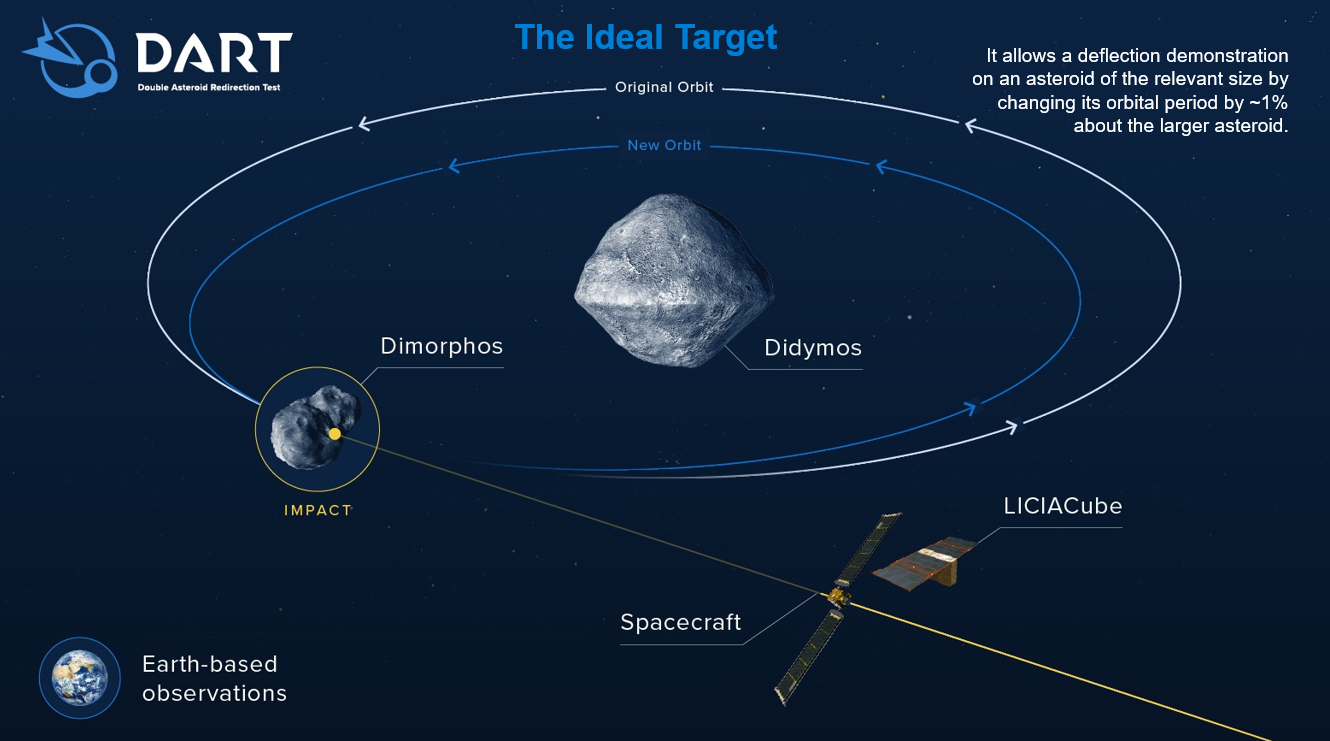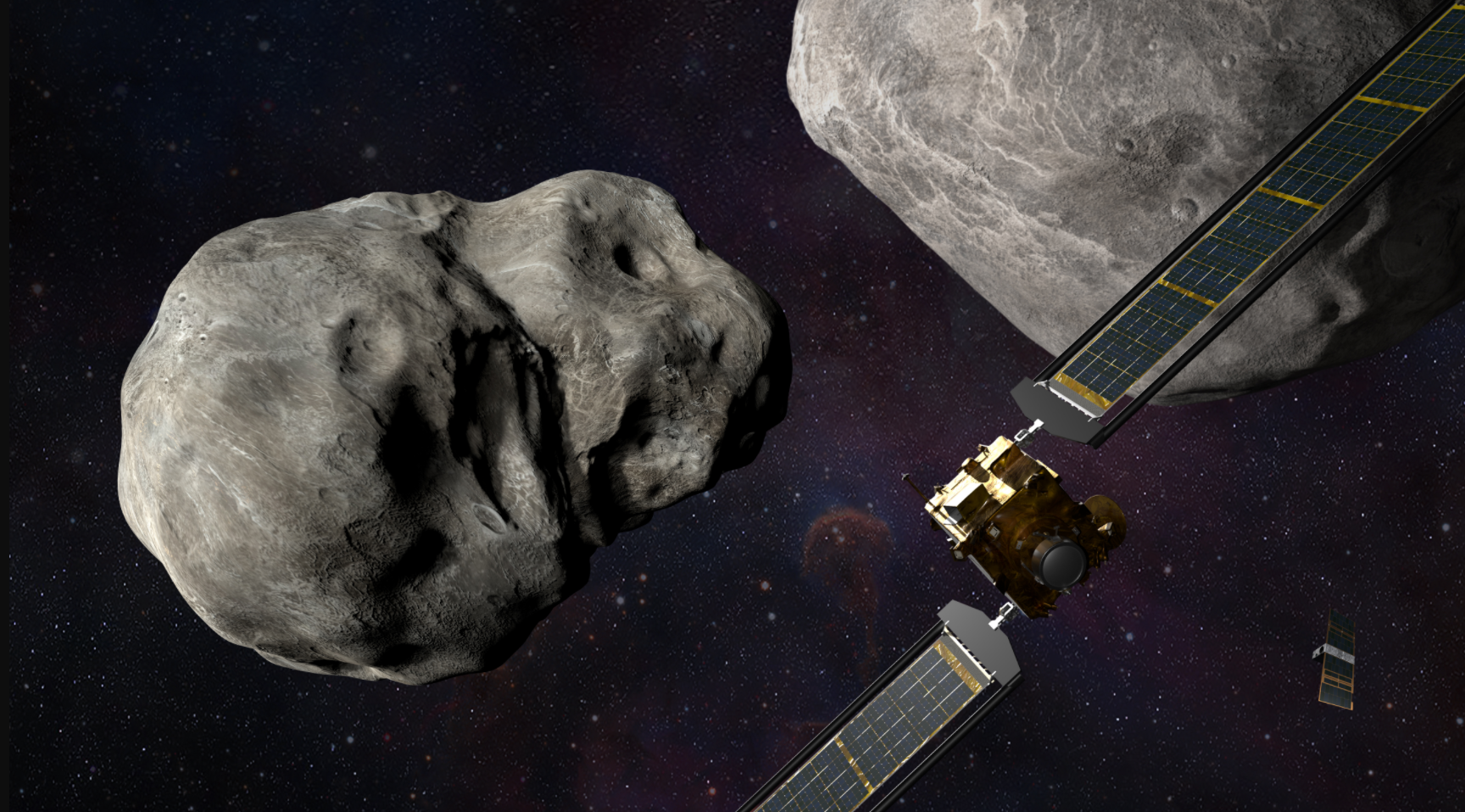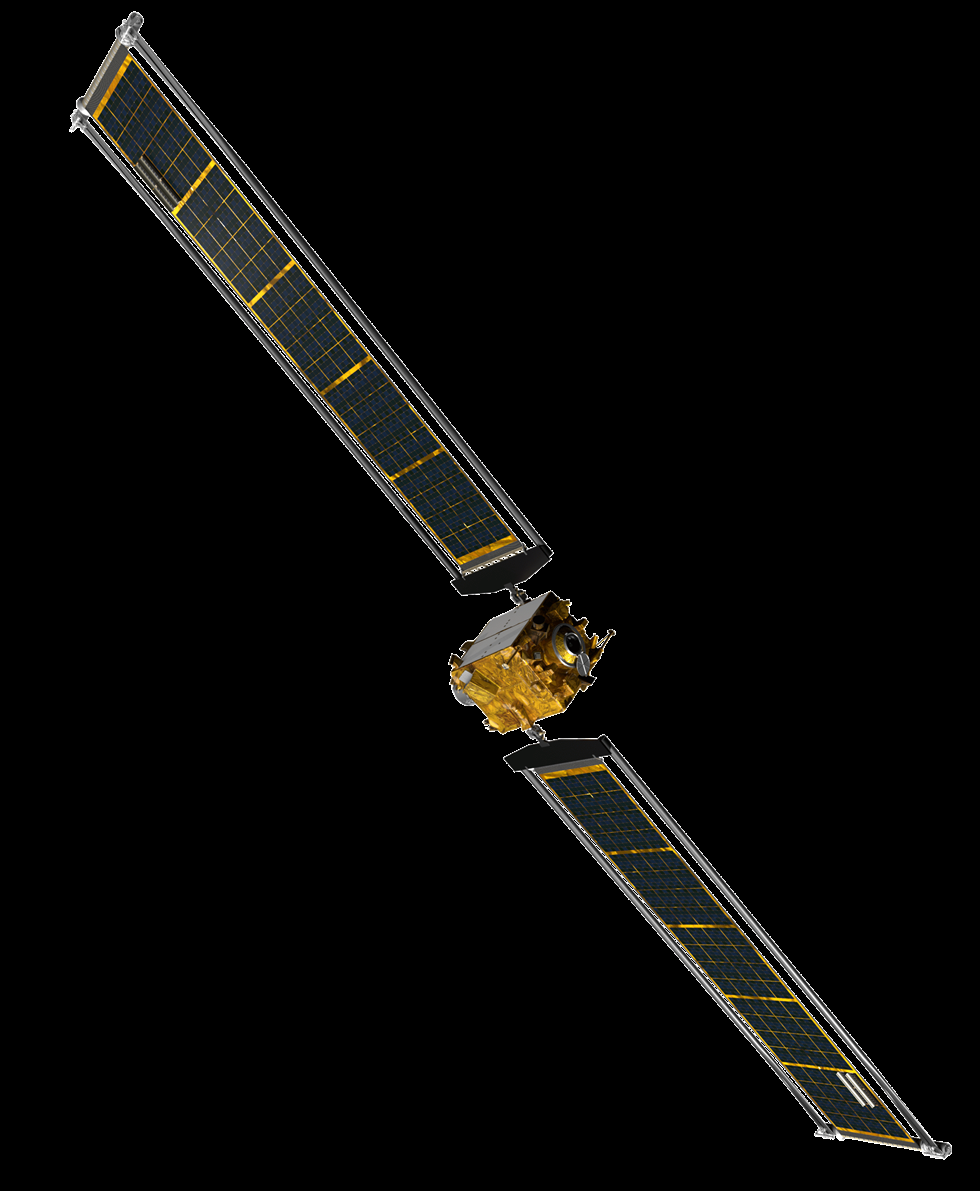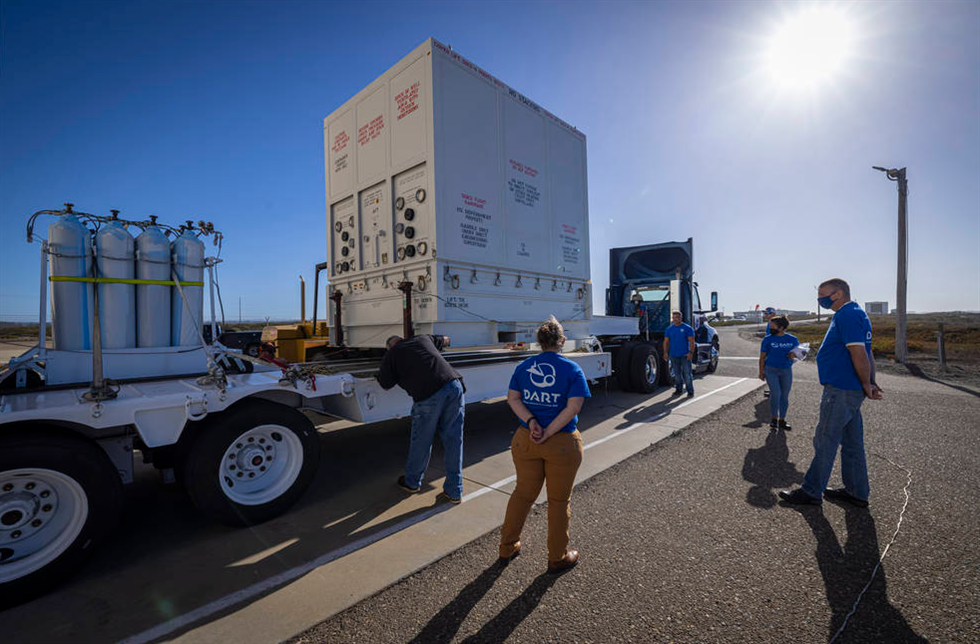DART: A Small Spacecraft with Big Implications in Planetary Defense
Defensive moves will go from the chessboard to the asteroid belt when the Double Asteroid Redirection Test (DART) mission gets off the ground. DART will be the first attempt to send a spacecraft on a collision course with an asteroid to change its trajectory.
DART is not only NASA’s — but humanity’s — first planetary defense mission.
Scheduled to launch aboard a SpaceX Falcon 9 rocket no earlier than 12:20 a.m. CST on Nov. 24 from Vandenberg Space Force Base in California, in about a year’s time, DART will impact Dimorphos to change its orbit within the Didymos binary asteroid system.
While the Didymos system poses no actual impact threat to Earth, it is the ideal target for this demonstration of what is called the kinetic impactor technique. Scientists will be able to measure the change in Dimorphos’ orbit around Didymos with ground-based telescopes. The change in Dimorphos’ orbit will be key in determining how effective the kinetic impact technique is for planetary defense.
No More Bad Days
“There are things out there called near-Earth objects, asteroids and comets, that can present a hazard to the Earth,” said Paul Abell, chief scientist for Small Body Exploration within NASA Johnson Space Center’s Astromaterials Research and Exploration Science Division. “We’ve had good evidence that major impacts in the past have altered life on the planet. If you think about 66 million years ago, dinosaurs went extinct because a large asteroid hit in the Yucatan peninsula of Mexico. That was a very, very bad day for them. But the dinosaurs didn’t have a space program — we do.”
More recently, in 2013, a meteor exploded over Chelyabinsk, Russia, injuring over 1,600 people, once more demonstrating that, for now, we Earthlings are vulnerable to near-Earth objects — especially those masked by the blinding light of the Sun.
“It was just a small asteroid, about the size of a large bus, but it caused a lot of damage,” Abell said. “And asteroids hit us all the time. Fortunately, they’re usually small and detonate high in Earth’s atmosphere, but it doesn’t take a very big asteroid to give us a bad day. It is those bigger asteroids, about half a football field and larger, that we are concerned about finding. And, if we see one coming, we want to be ready to deflect it.”
Abell explained, “It’s ramming into an asteroid at high speed and showing that we can actually, first of all, hit the asteroid, and then move it off course and deflect it.”
DART will test our ability to deal with an incoming cosmic threat before it can give Earth a bad day.
“Whenever we do things at NASA, whether it be for rocket launches or spacewalks, we simulate — we practice,” Abell said. “It is the same thing for planetary defense. We want to make sure that we have confidence in our techniques and procedures and learn how near-Earth objects respond to our deflection attempts. We really don’t want to be in the position where we must get it right the first time we detect a dangerous asteroid headed our way. That’s a little bit too risky if there is an object headed toward Earth, and with potentially catastrophic consequences.”

The Main Event
When the DART spacecraft crashes into Dimorphos, the little moonlet of Didymos, NASA and its international partners will watch the action unfold from Earth using optical telescopes and planetary radar.
“We’re going to see a change in the orbit period, and we can measure that from our ground-based telescopes,” Abell said. “Since we know roughly how big Dimorphos is, if we know how much we slowed it down, we know how much oomph — momentum — we’ve transferred to it and actually calculate the deflection.”
Abell, the Johnson expert regularly tasked with spacecraft missions involving asteroids, is serving on DART’s investigation team, organizing some of the Earth-based observations of the Didymos binary asteroid system before, during, and after impact, and helping to interpret the aftermath.
As with most NASA missions, this one is a multi-nation endeavor, because planetary defense is in everyone’s best interest.
A cubesat provided by the Italian Space Agency will also be deployed a few days prior to impact to ride along behind DART. It will get a front-row view of what happens at the moment of collision and relay that snapshot of data back to Earth.
“We’ll get some really good information on how much material is thrown off,” Abell said. “The whole idea behind the kinetic impact deflection technique is that you transfer momentum into the asteroid, you hit it at high speed, you give it a push … but also what happens is you throw off a lot of what we call ejecta — a lot of rock and debris are liberated. That acts as an extra force, a momentum enhancement, and that’s what we’re also trying to measure.”

Illustration of NASA’s DART spacecraft and the Italian Space Agency’s LICIACube prior to impact at the Didymos binary system. Credits: NASA/Johns Hopkins, APL/Steve Gribben
In Defense of Our Planet
Abell thinks there are limitless possibilities when it comes to NASA learning from asteroids on the way to farther-off destinations like the Red Planet.
“They’re the leftover building blocks of the solar system,” Abell said. “They’re like time capsules, telling us how the solar system formed, what it was like … These are really ancient materials, and they tell us a lot about how life evolved on the planet. From a science perspective, they are just amazing.”
NASA protects the planet through the Planetary Defense Coordination Office, and this mission is the first where the agency will be able to say that if an asteroid is coming toward us — with enough warning time, we just may be able to deflect it.
Following DART are two other planetary defense missions: an infrared space telescope called NASA’s Near-Earth Object Surveyor and Hera, an ESA (European Space Agency) undertaking that will conduct a detailed assessment of Dimorphos, the target of NASA’s DART kinetic impactor test, in the 2026 timeframe. Both have tremendous implications for planetary defense.
The Near-Earth Object Surveyor telescope is slated to launch in 2026 and will be positioned between Earth and the Sun, acting as an early warning system. This telescope will fill the gaps currently experienced when relying on nighttime observations from telescopes to capture the light bouncing off asteroids. Had this observatory been operational in 2013, astronomers may not have missed the threat looming with the Chelyabinsk meteor.
“We can’t see things coming from the direction of the Sun, and that’s what happened with Chelyabinsk,” Abell said.
But, with an infrared space telescope that can operate 24/7 between us and the Sun, we won’t have to rely on detecting the reflected light from these near-Earth objects. It turns out that even though dark asteroids are challenging to see in visible light, they really stand out in infrared wavelengths.
“The number one thing about planetary defense is find them early, find them early, find them early,” Abell said, because with time countermeasures such as DART could prevent a disaster in the making.
Abell is no big fan of cataclysmic space movies, and he wants NASA and its partners to be in the position to find threats decades in advance — “to deal with them in a very calm, leisurely manner. You don’t want to go into these last-minute heroic measures, or not see it coming at all.”
While there is no imminent danger from any known asteroid or comet, planetary defense is a global endeavor, and one where NASA is leading the charge with this test in deflecting a near-Earth object.
“There are other techniques out there that we’re looking at developing, but this is the first, the simplest technique — and we’re really excited about it,” Abell said. “I like this mission because it applies science to protecting the planet. It is really all for the public good — preventing a huge natural disaster from ever happening. It’s, in some ways, similar to the things we do with climate change, and it has direct applications for humanity in the future.”
Watch, below, as astronauts show how NASA’s DART mission will change an asteroid's motion in space.
NASA Team Invited to Share Excitement of DART Launch
Live coverage begins on the agency’s website with the NASA EDGE: Live DART Show at 11 a.m. CST on Nov. 23, with countdown commentary beginning at 11:30 p.m. CST Nov. 23 on NASA Television, the agency’s website, the NASA app, and NASA social media.
NASA employees and members of the public also can share in the journey through a variety of activities, including:
Planetary Defenders Campaign
Participants can answer a short series of questions about planetary defense to earn their planetary defender certificate, which they can download and/or print, as well as a digital badge to share on social media.
To participate, visit: https://dart.jhuapl.edu/Planetary-Defender
Virtual Launch Passport
Print, fold, and get ready to fill your recently updated virtual passport. Following launches, stamps will be emailed to those who register through Eventbrite.
Virtual Guest Program Website
NASA’s new virtual guest program website brings the space launch experience, along with the excitement and hope of these critical moments, to anyone with a connected device. Sign up now.
Watch and Engage on Social Media
Stay connected with the mission on social media, and let people know you're following it on Twitter, Facebook and Instagram. Follow and tag these accounts:
- Twitter: @NASA, @NASASolarSystem @AsteroidWatch
- Facebook: NASA, NASA Solar System
- Instagram: NASA, @NASASolarSystem
Additional information about the DART mission can be found on the mission’s websites: https://www.nasa.gov/planetarydefense and https://dart.jhuapl.edu
Join NASA as it goes forward to the Moon and on to Mars — discover the latest on Earth, the Solar System and beyond with a weekly update in your inbox. Subscribe at:









